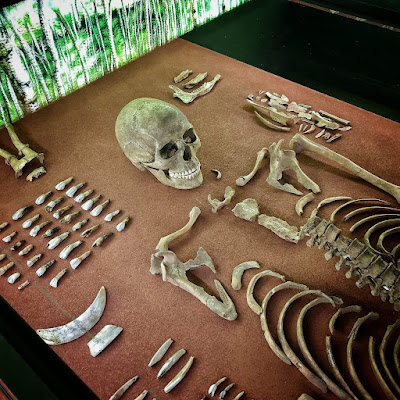
The shaman of Bad Dürrenberg are the remains of a 25-35 year old woman, who was burried 8600 to 9000 year ago in Germany. Around her, were the remains of an extraordinary head-dress, made from the bones and teeth of different animals such as deer, wild boar, crane and turtle
aIn the shade of the forest there is space for encounters of a special kind. The 25 to 30-year-old woman was buried bedded in raddle around 9,000 years ago. The lavish inventory of grave goods attests to a special social role of the deceased. The enormous diversity of animal species represented in the grave, of which not all would have been just food supplies for the afterlife, is remarkable. Ethnographic comparisons suggest that some objects are to be interpreted as requisites of shamanistic practices. The transition from mobile foraging to the sedentary way of life with agriculture and cattle breeding around 5600 BC marked the end of the Mesolithic. The age of the hunters – as the longest phase of human lifestyle – came to an end.
The grave of the Bad Dürrenberg shaman is the oldest burial in central Germany. An infant was buried with her. The analysis of the woman’s skeleton revealed that her uppermost cervical vertebra was malformed and that blood vessels in the lower skull area could have been spatially restricted. This malformation may have made her a special person. Anthropologists suspect that through extreme positions of her head she could have even deliberately induced herself to faint. The overabundant inventory of grave goods alone testifies to a special social role of the deceased. Certain grave goods also played an important role in interpreting this burial as a shaman’s grave.







